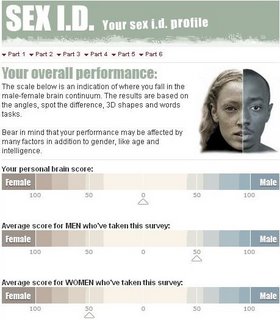Brain Sex I.D.

(click to view overall results)
Brain Sex I.D. Quiz
http://www.bbc.co.uk/science/humanbody/sex/add_user.shtml
(printable mm ruler, you'll need it [pdf])
Angles
This task tested your ability to identify the angle of a line by matching it with its twin. This is a spatial task, which looks at how you picture space.
Your score: 11 out of 20
Average score for men: 15.1 out of 20
Average score for women: 13.3 out of 20
What does your result suggest?
If you scored 0 - 12: You have more of a female brain. Scientists believe that people with a female brain find it more difficult to judge the slope of a line because they're not wired for spatial tasks. In past studies, 65 per cent of people who scored in this range were women.
If you scored 13 - 17: You found this test neither hard nor easy. This suggests your brain has male and female traits when it comes to spatial ability.
If you scored 18 - 20: You have more of a male brain. On average, men outperform women in this task and those with more mathematical knowledge tend to score quite high as well. In past studies, 60 per cent of the people in this range were men.
Interestingly, men's testosterone levels fluctuate through the seasons and studies have shown that men's scores are lower in the spring, when their testosterone levels are at their lowest.
Do our cave dwelling ancestors offer us any clues about why men and women score differently on this task?
Spot the difference
This task tested your ability to identify which objects changed position. You lost points, if you incorrectly identified objects.
Your score: 50%
Average score for men: 39%
Average score for women: 46%
What does your score suggest?
If you scored between 0 - 33%: You may have more of a male brain. Scientists say men tend to under perform in this task. The corpus callosum, the part of the brain that links the right and left hemispheres, is a fifth larger in women. This means women can process visual and other signals at the same time more easily than men. There is also a theory that oestrogen levels in women give them an added advantage in spatial memory.
If you scored between 34 - 66%: You may have a balanced female-male brain.
If you scored between 67 - 100%: Those with a female-type brain generally score in this range. Your ability to remember where objects are may serve as an advantage to you when you're trying to find your way around places. You're more capable of recalling landmarks to get from one place to another.
Part 2
Hands
You said your left thumb was on top when you clasped your hands together.
Right thumb on top: This suggests the left half of your brain is dominant. Many studies have tried to establish whether there is a relationship between handedness and brain dominance. Some scientists believe that if you are left brain dominant, you would be more verbal and analytical.
Left thumb on top: This suggests the right half of your brain is dominant. Some studies theorise that as a right brain dominant person, you may excel in visual, spatial and intuitive processes.
However, these theories are debatable and leave much to be said about the small percentage of people who are ambidextrous.
Part 3
Emotions and Systems
This task looked at whether you prefer to empathise or systemise.
Empathising
Your empathy score is: 12 out of 20
Average score for men: 7.9 out of 20
Average score for women: 10.6 out of 20
What does your result suggest?
Empathisers are better at accurately judging other people's emotions and responding appropriately. If you scored 15 and above, you are very empathic and would be an ideal person to comfort people in a time of crisis. Women in general are better at empathising.
Systemising
Your systemising score is: 15 out of 20
Average score for men: 12.5 out of 20
Average score for women: 8.0 out of 20
What does your result suggest?
Systemisers prefer to investigate how systems work. A system can be a road map, flat pack furniture, or a mathematical equation – anything that follows a set of rules. A score of 15 and above suggests you're good at analysing or building systems. Men in general are better at systemising.
Scientists are keen to learn more about people who score high or low on both tests. They want to find out whether or not empathising and systemising are linked. Is a possible to make yourself more empathic?
Some scientists claim that our empathy and systemising abilities can be traced all the way back to prehistoric times. Find out more.
Eyes
This task tested your ability to judge people's emotions.
Your score: 8 out of 10
Average score for men: 6.6 out of 10
Average score for women: 6.6 out of 10
What does your result suggest?
If you scored 0 - 3: Do you think you're good at judging how another person is feeling? Your score suggests this doesn't come to you quite so naturally.
If you scored 4 - 6: Your result suggests you have a balanced female-male brain and find it neither easy nor difficult to judge people's emotions.
If you scored 7 - 10: Your result suggests you are a good empathiser, sensitive to other people's emotions. Women generally fall into this category.
Professor Baron-Cohen at the University of Cambridge says that people usually perform better than they expect to on this test.
Men often think a person's eyes are sending signals of desire when that's not the case at all.
Part 4
Fingers
We asked you to measure your ring and index fingers. Your ratios came to:
Right Hand: 0.992
Left Hand: 0.989
Average ratio for men: 0.982
Average ratio for women: 0.991
It's thought that your ratio is governed by the amount of testosterone you were exposed to in your mother's womb. The ratio of the length of your index finger to the length of your ring finger is set for life by as early as three months after conception. Even during puberty, when we experience intensive hormonal changes, the ratio stays the same.
Men generally have a ring finger that is longer than their index finger, which gives them a lower ratio than women, whose ring and index fingers are usually of equal length.
Studies have found that men and women with lots of brothers generally have more masculine finger ratios. Find out what other things scientists think our ratios may tell us.
Part 5
Faces
This task looked at how you rate the attractiveness of a series of faces. The images you looked at were digitally altered to create slight differences in masculinity.
Your choices suggest you prefer more masculine faces.
Highly masculinised male faces possess more extreme testosterone markers such as a long, broad and lower jaw, as well as more pronounced brow ridges and cheekbones.
Interestingly, women's preferences are said to vary across the menstrual phase. A more masculine face is preferred during the 9 days prior to ovulation, when conception is most likely.
A typical 'attractive' female face possesses features such as a shorter, narrower, lower jaw, fuller lips and larger eyes than an average face.
Part 6
3D shapes
This task tested your ability to mentally rotate 3D shapes.
Your score: 10 out of 12
Average score for men: 8.2 out of 12
Average score for women: 7.1 out of 12
What does your result suggest?
If you scored 0 - 6: Do you find yourself having to physically rotate a map to point in the direction in which you're travelling? This might explain why you scored in the lower range in the 3D shapes test. Twice as many women as men score in this category. Previous studies suggest that those with a female-type brain or with an arts background fall into this range.
If you scored 7 - 9: In past studies, 50 per cent of the people who scored in this range were women and 50 per cent were men.
If you scored 10 - 12: Are you an engineer or do you have a science background? People with these skills tend to score in this range. Past studies have concluded that people in this range have a more male brain.
Nearly a third of men who took this test got full marks, whereas less than 10 per cent of women managed the same.
Words
This task looked at your verbal fluency.
Your score: you associated 7 word(s) with grey and you named 17 word(s) that mean happy. We are assuming that all the words you entered are correct.
Average score for men: 11.4 words total
Average score for women: 12.4 words total
What does your result suggest?
If you produced 1 - 5 words: You are more of the strong, silent type with a male brain. You probably find it easier to express yourself in non-verbal ways, preferring action rather than words.
If you produced 6 - 10 words: Most people in this range have a female-type brain.
Women are said to use both sides of the brain when doing verbal tasks while men mainly use their left side. Studies have shown that girls develop vocabulary faster than boys. This difference in brain power is caused by levels of pre-natal testosterone.
Ultimatum
This task asked you how you would divide money.
If you had to split £50 with someone, you said you would demand £25
So far on the Sex ID test, men have demanded 51.6% (£25.80) of the pot and women have demanded 51.0% (£25.50), on average.
What does your response suggest?
Sex differences are small in this task. Demanding less than 60% of the pot (ie £30) is more typically female. Demanding more than 65% of the pot (ie £32.50) is more typically male.
Scientists believe that people with lower testosterone levels tend to take fewer risks so they are probably more willing to keep less for themselves. Those with higher testosterone levels tend to drive a harder bargain and are less compromising.
Men's testosterone levels fluctuate over the seasons and are at their lowest levels during the springtime. This is said to influence their bargaining power.



0 Comments:
Post a Comment
<< Home